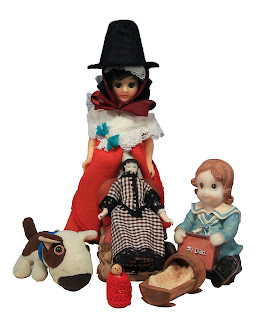by Robert Louis Stevenson
Under the wide and starry sky
Dig the grave and let me lie.
Glad did I live and gladly die,
And I laid me down with a will.
This be the verse you grave for me;
"Here he lies where he longed to be,
Home is the sailor, home from sea,
and the hunter home from the hill."
 |
| Vintage Cloth doll of a 19th c. sailor |
Home is the Sailor
by A.E. Houseman
Home is the sailor, home from sea:
Her far-borne canvas furled
The ship pours shining on the quay
The plunder of the world.
Home is the hunter from the hill:
Fast in the boundless snare
All flesh lies taken at his will'
And every fowl of air.
'Tis evening on the moorland free,
The starlit save is still:
Home is the sailor from the sea,
The hunter from the hill.
 |
| Dolls representing the family from Godden's Home is the Sailor |
I was born near an ocean, and my great grandfather, grandfather, and cousin were all sailors. These two poems inspired the title of one o f my favorite novels on dolls, Rumer Godden's Home is the Sailor. The book means even more to me because Godden herself wrote to me when I was writing my dissertation.
 |
| The Doll's Shell Garden from Home is the Sailor |
Years later, I would present conference papers and write articles about Rumer Godden, but sad serendipity reminded me of the poems that launched the title of her novel about a family of doll house dolls in Wales suffering loss because three of their sailors disappeared, and ultimately, returned home.
Here is an excerpt from one of my papers on Godden, with emphasis on Home is the Sailor:
Godden is also seen as a post colonial,§ white writer, who writes in the last days of the British Empire as it was then know, as Le-Guilcher writes, Godden written “when the British Empires struggled to yield the last vestiges of global Power (Le-Guilcher 2010). Of her geographical settings, which are as much Godden’s characters as any Nona or Belinda, or Tottie, Le-Guilcher and others comment that Godden’s settings “engage a modernist uncertainty about her own position as representing such nomadic Others as gypsies, as well as the displacements of war and discontents of domestic and family life “ (Ibid). This last theme of domestic discontent and displacement often dominates her children’s’ works like Home is the Sailor, A Dolls House, Miss Happiness and Miss Flower, Little Plum, The Story of Holly and Ivy and Impunity Jane. It is a running theme in China Court, An Episode of Sparrows, Peacock Spring, Five for Sorrow, Ten for Joy,[1] and her other adult novels. It is uncommon for Rumer Godden to write of the “condition of enforced and elected exile within the changing political and cultural borders of colonial and postcolonial nations” (Le-Guilcher Introduction 2010).
§ Note that
“Post-colonial” . . . refers to the period after independence but it covers all
the cultures affected by the imperial process from the moment of colonization to
the present day . . .” (Zabus 2).
[1] Greengage
Summer deals with “adolescent and midlife angst.” Chisholm writes the
subject of GGS is “emotional growing pains and the potent mixture of guilt and pleasure that accompanies the
discovery of sex” (Chisholm 199, 250 quoted in LeGuilcher, Introduction
2010. The same theme appears in Peacock
Spring.



























































wCWk~%24(KGrHqV,!h8Ew5GsnS3dBMUy3MzVPg~~_3.jpg)






































































No comments:
Post a Comment